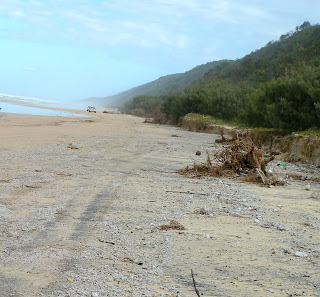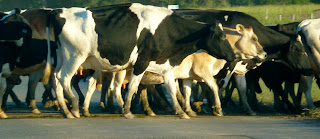Water has always been a big issue in Australia. Beleaguered farmers working prime agricultural land have long argued that groundwater baseline studies are necessary before mining companies with exploration leases even think about drilling wells or excavating mines. Independent MP Tony Windsor, whose constituency includes rich agricultural land under threat from miners in New England, New South Wales, introduced a 'water trigger' amendment to the Government's bill so that final approvals for CSG wells must be the domain of the Commonwealth, not state governments.
Jeff Seeney is Deputy Premier and Minister for State Development, Infrastructure and Planning in the ruling LNP Coalition in Queensland. He is not a personable man: he always look a bit lip-curly; he smiles infrequently; he talks to journos and broadcasters with a hint of derision. When he's interviewed in his constituency of Callide, a large electoral division including key farming regions such as the Burnett as well as mining towns, he wears an Akubra (iconic bush hat) and a cattleman shirt. Until 2008 he was a member of the National Party. Are you getting the picture?
Mr Seeney doesn't like 'green tape'. It prevents the LNP government from doing what it wants to do, whether that is approving more mines or coal exporting ports, allowing cattle to graze in national parks, permitting farmers to clear more native vegetation, or freeing up the commercial dumping of other states' rubbish in Queensland.
This week he has revealed what he really thinks about people who are concerned about the above. He encouraged oil and gas companies to stand up to the efforts of environmental groups, whom he accused of trying to delay and halt every project in the resource sector. He was addressing the Australian Petroleum Exploration and Production Association in Brisbane on Wednesday.
'We see it daily in Queensland where every proposal for development is portrayed as a threat that will lead to total destruction of the Great Barrier Reef. Not only is it claimed that LNG plants in Gladstone harbour will kill the Reef... port development, wherever it is proposed, will apparently kill the Reef.
New mines, hundreds of kilometres inland, will kill the Reef.
Even ships carrying bauxite from the other side of the Cape will kill the Reef.
Take up the fight against the radical greens campaign... because it has the potential to cost your industry many times more [than the mining super profits tax].'
This is the man, of course, who stated in the early days of the LNP state government that the Great Barrier Reef was hundreds of kilometres away from Gladstone.
He has many allies in the Federal Opposition, too. Coalition resources spokesperson Ian Macfarlane has declared, should they come to power in September, they will 'get around' the new legislation and hand over environmental assessment procedures solely to the states, although standards will be determined by the Commonwealth.
I'm pleased that Mr Macfarlane has such faith in the Expert Scientific Committee. I hope he recommends it to Jeff Seeney. Under the Coalition's proposals to hand back approval of EISes to the states, how will he, or the Queensland Government, ensure the standards set out by the Committee are adhered to in future? A grand idea is all well and good, but a management plan must be put in place to monitor progress and results in the form of hard data.
Meanwhile, Mr Seeney moves on to mine water releases and Gulf water resource planning. Is anything safe on his watch?
He has many allies in the Federal Opposition, too. Coalition resources spokesperson Ian Macfarlane has declared, should they come to power in September, they will 'get around' the new legislation and hand over environmental assessment procedures solely to the states, although standards will be determined by the Commonwealth.
'We'll delegate approvals to the states. We already have an expert panel to assess water impacts. Labor is assuming the state governments are incompetent and don't have processes in place to deal with it.'I assume he was referring to the Independent Expert Scientific Committee on Coal Seam Gas and Large Coal Mining Development set up in November 2012 as part of amendments to the Environment Protection and Biodiversity Conservation Act (1999). This was in response to community concerns about the 'critical gaps in scientific understanding of the water-related impacts associated with coal seam gas and large coal mining activities'. The committee was announced after Tony Windsor and another Independent, Rob Oakshott, obtained Julia Gillard's commitment in return for their support for the Government's Mineral Rent Resource Tax, aka the mining tax.
I'm pleased that Mr Macfarlane has such faith in the Expert Scientific Committee. I hope he recommends it to Jeff Seeney. Under the Coalition's proposals to hand back approval of EISes to the states, how will he, or the Queensland Government, ensure the standards set out by the Committee are adhered to in future? A grand idea is all well and good, but a management plan must be put in place to monitor progress and results in the form of hard data.
Meanwhile, Mr Seeney moves on to mine water releases and Gulf water resource planning. Is anything safe on his watch?


































